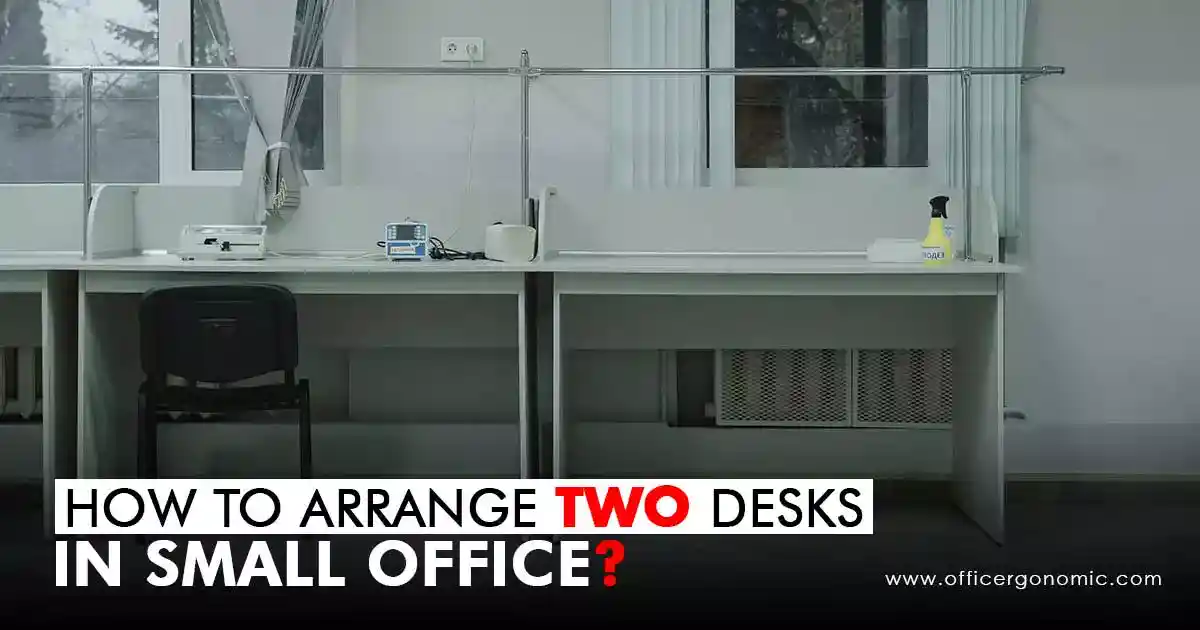How to Arrange Two Desks in a Small Office?
More often than not, there can be situations where two people have to adjust their working stations in the same room. You can be roommates, cabin colleagues, or even partners who work from the same room and need individual work desks.
It is specifically an issue when the room is small and two desks are to be placed optimally in such a way that both the workers are comfortable and productive concerning their work. Sharing the same room for work is not convenient for many people but if two desks are arranged thoughtfully, in a well-defined layout, there can be no hindrances for anyone.
So, “how to arrange two desks in a small office”? The desks can be arranged in diagonal or adjacent corners, in the middle of the room, in a T shape, or an L shape. Sometimes, even two desks are not needed. You can set your workstations on the opposite ends of a dining table or a built-in concrete table.
What should be considered while setting up a Two desk Office?
A limited workplace does not mean that two work desks cannot be arranged simultaneously. But some things are necessary to consider while designing a layout to place two desks. Some factors that are crucial and cannot be compromised are:
- Doorways that impact traffic flow
- Position of windows that obscure computer display visibility
- Location of electrical outlets and switches
- The left- or right-handedness of the occupants (yes, this matters!)
Every individual typically needs a desk, chair, file cabinet, and maybe a visitor’s chair. Office equipment like bookshelves, cabinets, scanners, or printers can be shared and do not hinder the placement of two desks. Although the layouts and designs explained in this article are all for one-door, one-window rooms, the concepts learned from them can be applied to any kind of space.
How to Arrange Two Desks in a Small Office?
In the section below, you will come to know some effective ways to arrange two desks in a small office.
Parallel back-to-back seating:
If you get easily distracted by some nearby person during work, this layout is best for you. To reduce the likelihood of your co-workers interrupting you during the day, choose a seating position behind them. Sit in such a way that both of you face the opposite walls. Keep the ergonomic chairs and tables light so that the room feels more spacious. In this case, the scanner, printer, or any other shared resource can be placed close to the desk, who uses it the most.
Parallel face-to-face setting:
Join the two desks from their front ends. Both the users will be working in front of each other. The cupboard or shelf can be placed in either corner or side. To avoid any disturbance, you can place wall dividers or panels between the two desks. It is good for the rooms which have a window opposite to the door and the pair of desks are placed perpendicularly in front of the window. In this way, the doorway remains free of any hindrance.
Use dining table seats:
If you do not have a dedicated room for one person, think about turning your dining area into the main office. Each of you can have your workspace by taking a seat at opposing corners of a large, wooden table. It fosters a sense of isolation but permits communication throughout the day. Rounded oval dining area desks are great for collaboration because one can glide around the table to work closer with your partner. This is especially useful if you and your spouse run a business together or if you and your kids assist each other with chores. A dining table with a table tulip base will give you plenty of area for legs as well.
Facing the same wall:
Workplaces with two workstations and two distinct work zones are a wonderful idea. To maximize your personal space, start by positioning your standing workstations for the business or home at the farthest points of the wall. Next, mount some bookshelves for personal belongings and office supplies in the space between the two workstations. Designate the space on the bookshelf for each worker for ease.

L-shaped Corner:
Let’s say you have no interest in the parallel arrangement. In that scenario, it would be preferable to set up a corner desk workstation for two people. This idea not only saves room but also makes it easy for you and your spouse to stay close to one another.
Diagonally corner layout:
You can always try positioning two workstations in corners diagonally if you would like to keep the middle of the space open. This is a particularly smart move if your workstations are L-shaped corners and you both have them. This is an extremely useful technique if two people need to work in the same room with their equipment but do not want to face each other or be distracted by each other.
Adjacent corner arrangement:
Apply this setting, if the width of the room is less than its length. Set up the chair and table on the shorter length side. Install a cupboard or rack with a wall that extends from the floor to the ceiling.
T-shaped setting:
This arrangement of the office desks forms a T. Although it creates inconvenience for one person and compels him/her to move around the desk to reach things out, it provides space for an extra chair to be positioned in the corner.
Floating corner layout:
The question of how to set up two workstations in a tiny office is certainly tricky, so why not avoid the hustle of setting two desks? A small workspace will look stuffy if you try to fit two separate workbenches into that small space. As an alternative, consider building a shared floating desk in the corner. The floating desk can be made of wood, concrete, or plastic. Install wooden shelves above it to place the relevant things.
Separate but connected layout:
You don’t have to share a lengthy table with your partner just because you work in the same room. Alternatively, you can both have a different table and still be in contact with each other. The tops of both tables are connected by an inner rectangular dip. A smaller cabinet serves as a separator between the two workstations in the center. This kind of “separate but still connected” table concept gives a more coherent look to the room’s aesthetics.
Cabinet above workstation style:
If you are building a setup from scratch, then this is a very simple design. Install a wooden plank with the wall from one corner to the other. Above the plank, construct a wooden cabinet. You can even place a mirror on the cabinet’s doors so that you don’t have to put a mirror somewhere else. On the lower side of the cabinet, fix lights so that no additional table lamp is required. In this way, there will be no clutter on the desks as well as the room and you don’t even have to buy separate tables.
One facing the back of the other:
This type of arrangement is when one person is facing towards the back of the other person. Both of them have their workstations in a line and sit like they are sitting in a classroom. One drawback of this arrangement is that the person behind can easily see what the other person is doing on his computer. If you are living with a roommate and do not want to compromise your privacy, this layout may not be suitable for you.

U-shaped setting:
If the room is really small, just like a dorm, then try to line a shelf with the wall in a U shape that encompasses two corners and covers some side lengths as well. And if your desk doesn’t have drawers then you can create drawers and cabinets beneath that shelf to store your work-related things. Dorms do not have enough space to cater to two tables and students may need desks to study. So, this is a perfect arrangement for a dorm room.
Steps to take while arranging two desks in a confined space:
Follow the simple steps below to avoid an inconvenient experience:
Calculate your place’s dimensions:
Measure the size of your office to find out how much room you have before you start reorganizing. This will be useful when looking for new storage options or furnishings. A measuring tape or an internet application like RoomSketcher can be used for measuring. Make sure all windows and doors will still be accessible by measuring them beforehand. It is crucial to ensure that natural light is not restricted. Any exits should not be blocked.
Choose which way the desks will face:
Will one employee’s workstation be set up against a wall, the other facing the wall, or both facing the opposite way? This is the most important step. Make sure there is adequate room for both workers to walk around and reach filing cabinets or other storage options. You can choose from the above-mentioned options according to your choice.
Select Desk Types:
Select the desks that fit your tiny office. However, keep in mind the requirements of both workers. While one would require a standard desk to support their back, the other might choose a standing desk. Furthermore, it is better to keep light furniture in small spaces.
Arrange Electronics and Cords Wisely:
To reduce space, place electronics beneath the desk. Use cord holders or cable ties to keep cords neat. A power strip with a lengthy cord can also be used to access outlets that are far away from the desk. For ease of access, locate any printers or scanners adjacent to both employees.
Reassess and rearrange as necessary:
Do not be scared to rearrange or add new furniture or storage options to your small office space if your demands change over time. This can be done seasonally or as needed to maintain both employees’ comfort and productivity in the environment. Take caution not to put too much furniture or storage in your tiny workspace, so that you can easily renovate it later.
Bottom Line!
It may seem that setting two desks in a small room is a tedious task but trust me it is not. With a little bit of creativity, everyone can design an aesthetic and functional workspace that benefits both coworkers. If your priority is privacy, then use the layouts that separate the desks and faces opposite to each other. If you are more inclined towards interaction with your partner during work, then opt for more open arrangements. Measurements of the place and furniture play an important role in this process. Make sure to consider them well!







